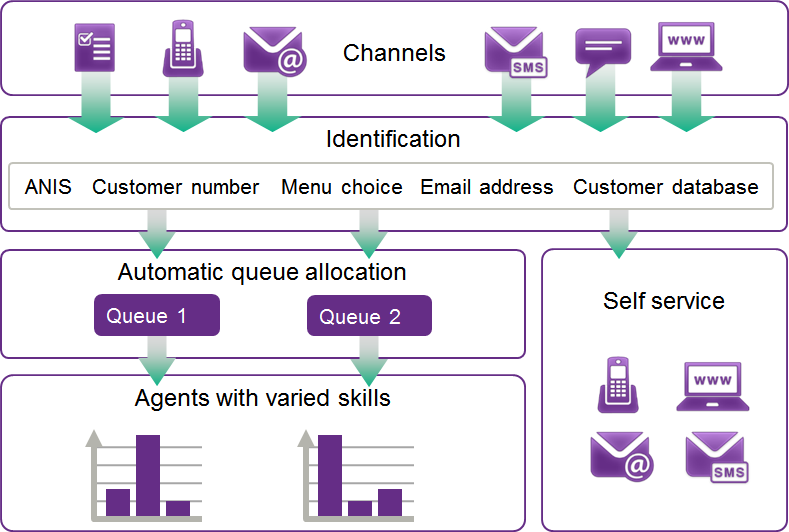
When you have skill based routing, the agent's skill profile, and not his geographical location, decides which queues for incoming and outbound calls, email and chat, he will be serving. You can trim the routing - to sort, prioritize, and distribute all kinds of contacts to the appropriate destination. Contacts can be routed by criteria combinations, such as
Contacts in ACE are either routed to a queue, or to a waiting list. When queues and waiting lists are created in ACE Admin, the administrator at the same time determines the required combination of skills, and/or groups for serving this very queue or waiting list. By routing the contacts to the appropriate queue or waiting list, you indirectly route to agents with the correct skill profile.

It is possible to configure the routing of the following types of contacts:
Routing and escalation work in the same way for all types of contacts above. The exception, routing of campaign calls, is handled in the windows where the campaign is created, under the Media | Outbound telephony menu choice.
For each contact, an amount of information known as contact data is automatically created. The basis for the contact data can come from e.g. a call’s IVR dialogue or a sender’s address in an incoming email.
Contact data are used in several ways in a ACE solution, for example in statistics. The interesting point here is that contact data are used to route contacts to appropriate agents.
Contact data for a particular contact comprise values for a number of parameters that are important for the current type of contact.
An IVR dialogue is often designed to give the calling party a number of menu choices, e.g. 1 (for orders) and 2 (for support).
Menu choices can be viewed as a parameter which, for a particular contact, can assume the value 1 or 2.
Another name for this type of parameter is “contact data key”, or just “key”. A particular contact has a particular set of contact data keys, each with a special value.
All contacts of a particular type (in a particular ACE installation) normally have the same set of contact data keys. All contacts of the “incoming calls” type can have ANIS among their contact data keys, for example. However, a contact of the “incoming email” type does not have any such contact data key.
The value of a contact data key does not have to be numerical. In principle, any text string can be processed, for example the word “support” instead of the digit 2.